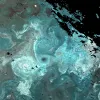
A team of UK scientists have embarked on a shipboard expedition to the Labrador Sea aboard the research vessel CCGS Hudson, to further understanding of how carbon dioxide is locked away from the atmosphere by ocean processes.
Led by Dr Stephanie Henson from the National Oceanography Centre, the team will measure the sinking of organic…

Microscopic ocean algae called coccolithophores are providing clues about the impact of climate change both now and many millions of years ago. The study found that their response to environmental change varies between species, in terms of how quickly they grow.
Coccolithophores, a type of plankton, are not only widespread in the modern ocean but…

More than a hundred marine scientists, policy makers and members of industry have unanimously called for action towards an integrated network of observatories monitoring Europe’s seas.
Speaking at a forum ‘Towards a European Network of Marine Observatories’ held by the Marine Board of the European Science Foundation, Professor Richard Lampitt of the…

Computer simulations performed by researchers at the National Oceanography Centre and the University of Glasgow show how oceanic stirring and mixing influence the formation and dynamics of plankton patches in the upper ocean.
Tiny free-floating marine plants called phytoplankton live in vast numbers in the sunlit upper ocean. Through the process…

In May 2010, the National Oceanography Centre (NOC) joins forces with the UK Met Office to enhance ocean monitoring at the Porcupine Abyssal Plain sustained observatory (PAP-SO), the longest multidisciplinary open-ocean time-series observatory in Europe. This collaboration should both advance scientific understanding of the ocean and improve climate…

The movement of ocean eddies and other surface water masses over short timescales causes rapid changes in the community composition of marine algae (phytoplankton) in the sunlit upper ocean, according to new findings.
The research, which was conducted by scientists of the National Oceanography Centre (NOC), spotlights intimate links between surface…

Some regions of the deep ocean floor support abundant populations of organisms, despite being overlain by water that contains very little oxygen, according to an international study led by scientists at the National Oceanography Centre, Southampton. But global warming is likely to exacerbate oxygen depletion and thereby reduce biodiversity in these…

The impact on levels of carbon dioxide in the Earth’s atmosphere by the decaying remains of a group of marine creatures that includes starfish and sea urchin has been significantly underestimated, conclude scientists.
“Climate models must take this carbon sink into account,” says Mario Lebrato, lead author of the study. The work was done when he…